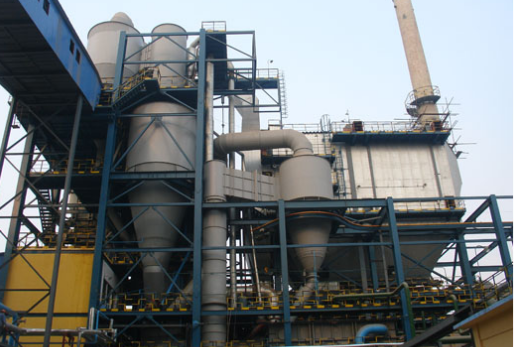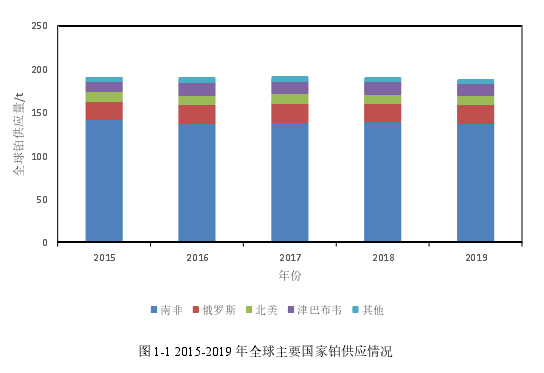摘 要
近些年,随着我国石油、化工行业发展,铂催化剂使用量逐年增加。在使用过程中,催化剂由于积碳、烧结等原因逐渐失去催化活性,需要定期进行更换。报废催化剂中铂资源丰富,远高于我国伴生矿中铂的含量,具有较高回收价值。
针对传统湿法回收工艺存在氧化剂毒性大、铂的制取复杂、综合利用程度低的缺点,本论文以某危废处置公司拟填埋的废铂催化剂为研究对象,开展了废催化剂焙烧脱碳、氧化浸出、萃取除杂、电沉积制备铂的试验研究,具体研究内容和结果如下:
(1)通过空气焙烧法脱除废催化剂表面积碳,采用单因素实验考察原料粒度、焙烧温度、焙烧时间对失重率的影响,得到最佳焙烧工艺条件:自然粒度、焙烧温度 650℃、焙烧时间 1.5 h,原料的失重率为 14.9%。
(2)通过盐酸氧化法浸出铂,采用单因素实验考察不同工艺参数对浸出率的影响,得到最佳浸出工艺条件:盐酸浓度 3mol/L、Na Cl O3加入量 6ml、液固比 8:1、反应温度 90℃、反应时间 90 min,Pt 浸出率达 99.5%。
(3)采用三正辛胺(TOA)萃取 Pt Cl62-,通过单因素实验考察不同工艺参数对萃取和反萃取的影响。研究结果表明,以 β-支链伯醇作为改性剂,可以有效消除萃取过程的第三相,最佳萃取条件为:料液[H+]=0.5 mol/L、TOA 体积分数 10%、β-支链伯醇体积分数5%、萃取相比(VO:VA)=1:1,Pt、Ni 的萃取率分别为 99.6%、0.2%。载铂有机相经稀 HCl洗涤,采用 0.2 mol/L Na OH 溶液反萃取 3 次,Pt 反萃取率达 99.8%,反萃取液经酸化、浓缩,主要成分为 Na2Pt Cl6和 Na Cl,杂质含量低,可用作电沉积制取铂的电解液。
(4)采用 2-乙基己基磷酸单 2-乙基己基酯(P507)分离 Al3+,经单因素实验考察不同工艺参数对萃取和反萃取的影响,得到最佳萃取条件:料液 p H=1.5,P507 皂化率 50%,萃取相比(VO:VA)=1:1,Al3+、Mg2+、Ni2+的萃取率分别为 99.3%、1.2%、0.5%。载铝有机相用 5 mol/L H2SO4反萃取,Al3+反萃取率达 98.5%,反萃取液经蒸发结晶,所得产物为 Al2(SO4)3·14H2O,质量满足 HG/T 2225—2010 中Ⅰ类品要求。
(5)通过线性扫描伏安法研究了 Pt Cl62-的电沉积过程,研究结果表明,Pt Cl62-电沉积的表观活化能大于 16 k J/mol,主要受电化学反应控制。提纯 Na2Pt Cl6溶液为电解液,采用恒压电沉积法制取金属铂,通过单因素实验考察搅拌、电压、电解液温度对铂电沉积率的影响,得到最佳电沉积工艺条件:低速搅拌,电压 2.0 V,电解液温度 50℃,铂的电沉积率为 99.5%,电沉积产物平整,Pt 含量达 99.98%。
通过成本收益估算,采用本文研发的成套工艺处理1 kg废铂催化剂,生产利润能达1100元。其中,废催化剂中铂的回收是产生良好经济效益的关键因素。
关键词 : 废催化剂;铂;回收;焙烧;萃取;电沉积。
ABSTRACT
In recent years, with the development of China's petroleum and chemical industry, the useof platinum catalyst has been increasing year by year. In the process of use, the catalyst willgradually lose its catalytic activity due to carbon deposition, sintering and other reasons, so itneeds to be replaced regularly. The abandoned catalyst is rich in platinum resources, which ismuch higher than the content of platinum in China's associated minerals. The spent catalyst hasa high recovery value.
In view of the disadvantages of the traditional wet recycling process, such as the hightoxicity of oxidants, the complex preparation of platinum, and the low degree of comprehensiveutilization, this thesis takes the spent platinum catalyst to be landfilled by a hazardous wastedisposal company as the research object and carries out the roasting and decarbonization of thewaste catalyst , Oxidative leaching, extraction, electrodeposition to prepare platinumexperimental research, the specific research content and results are as follows:
(1) The carbon in waste catalyst surface area was removed by air roasting. The influenceof raw material size, roasting temperature and roasting time on weight loss rate was investigatedby single factor experiment. The optimal roasting conditions were as follows: natural particlesize, roasting temperature at 650℃, roasting time at 1.5 h. The weight loss rate of raw materialsis 14.9%.

(2) Platinum was extracted by hydrochloric acid leaching. The optimum extractionconditions were hydrochloric acid concentration of 3mol/L, Na Cl O3addition amount of 6 ml,liquid-solid ratio of 8:1, reaction temperature of 90℃, reaction time of 90 min, the leaching rateof Pt is 99.5%(3) TOA was used to extract Pt Cl62-,and the effects of different process parameters onextraction and reverse extraction were investigated by single factor experiment. The resultsshowed that β-branched primary alcohol as the modifier could effectively eliminate the thirdphase in the extraction process. The optimal extraction conditions were as follows: solid liquid[H+] =0.5 mol/L, TOA volume fraction of 10%, β-branched primary alcohol volume fraction of5%, extraction ratio (VO:VA) of 1:1, Pt and Ni extraction rates of 99.6% and 0.2%. The platinumcarrying organic phase was washed by dilute HCl and stripped with 0.2mol /L Na OH solutionfor 3 times. The Pt stripping rate up to 99.8%. After acidification and concentration, the main components of the stripping solution are Na2Pt Cl6and Na Cl, and the impurity content is low. Itcan be used for electrodeposition to produce platinum electrolyte.
(4) P507 was used to separate Al3+, and the influence of different process parameters onextraction and stripping was investigated by single factor experiment. The optimal extractionconditions were p H=1.5, saponification rate of P507 of 50%, extraction ratio (VO:VA) of 1:1,the extraction rates of Al3+, Mg2+and Ni2+were 99.3%, 1.2% and 0.5%, The aluminum-carryingorganic phase is back-extracted with 5 mol/L H2SO4, and the back-extraction rate of Al3+reaches 98.5%. After the stripping liquid is evaporated and crystallized, the product obtained isAl2(SO4)3·14H2O, and the quality meets the requirements of Class I products in HG/T 2225—2010.
(5) The electrodeposition process of Pt Cl62-was studied by linear sweep voltammetry. Theresearch results show that the apparent activation energy of Pt Cl62-electrodeposition is greaterthan 16 k J/mol, which is mainly controlled by electrochemical reaction. Using the purifiedNa2Pt Cl6solution as the electrolyte, the metal platinum was prepared by the constant voltagedeposition method, and the influence of stirring, voltage, and electrolyte temperature on theplatinum recovery rate was investigated through single factor experiments. The bestelectrodeposition process conditions are low speed stirring, voltage of 2.0 V, electrolytetemperature of 50℃, platinum recovery rate can reach 99.5%. The electrodeposited product issmooth, and the purity of Pt is 99.98%.
Through cost-benefit estimation, the direct production profit can reach 1,100 yuan withthe complete process developed to treat 1 kg of spent platinum catalyst. The recovery ofplatinum from spent catalysts is a key factor for producing better economic benefits.
Key words : spent catalyst; platinum; recovery; roasting; extraction; electrowinning。
第一章 绪论
1.1、铂的性质、资源和生产现状。
铂,1735年被Ulloa发现,是一种高熔点、沸点的黑色或银白色金属。金属质地较软,有良好延展性、易于加工,导电、导热性优良。铂的化学性质稳定,可呈多种化合价态,易形成配合物,抗氧化性强,不溶于普通酸,可溶于王水和熔融碱,具有优良的催化活性[1,2]。
铂在地球表面上的含量稀少,矿产资源分布不均匀,大型铂矿主要分布在南北半球高纬度地区,沿纬度线呈环带状分布,主要存在于以铁镁质硅酸盐矿物为主要成分的超基性岩和基性岩中,大型含铂的矿场是硫化铜-镍矿型矿床,是全球铂储量和产量的主要来源,位于南非、俄罗斯、加拿大[3-5]。由于共生关系,铂矿中铂的品位一般低于10 g/t,经过复杂的富集过程,才获得铂含量高的精矿,然后再通过进一步的分离和提取,得到纯金属铂。
截至2018年,世界铂金属总储量为3.25万吨左右,南非Pt储量居首位,约占全球总储量的90.90%,其次是俄罗斯、津巴布韦、美国、加拿大,分别占比5.63%、1.73%、1.30%、0.45%[6]。根据2019年美国地质调查局(USGS)发布的数据,当前世界四大Pt生产国家、地区分别是南非、俄罗斯、津巴布韦、北美,主要生产国为南非,约占世界Pt生产总量的80%,处于绝对垄断地位,2014-2019年全球铂供应情况如图1-1所示[7]。

【由于本篇文章为硕士论文,如需全文请点击底部下载全文链接】
1.2 铂催化剂的应用和失活
1.2.1 铂的催化性质.
1.2.2铂催化剂的.
1.2.3铂催化剂的失活.
1.3废铂催化剂回收技术
1.3.1 预处理
1.3.2铂的富集
1.33铂的溶解.
1.3.4 铂的分离.
1.3.5铂的精炼.
1.4 电沉积技术简介
1.4.1 电沉积原理.
1.4.2电沉积制备纯金属的.
1.5选题意义
1.6技术路线
1.7研究内容
第二章 实验部分
2.1实验原料、试剂和设备
2.1.1实验原料.
2.1.2实验试剂与材料.
2.1.3实验主要设备.
2.2表征方法
2.3分析方法.
2.3.1分析仪器与工作参数.
2.3.2分析线选择和工作曲线绘制
2.3.3精密度和回收率试验.
2.3.4废催化剂元素含量分析.
2.4原料表征
2.4.1原料结构.
2.42原料形貌.
2.4.3原料成分.
第三章. 催化剂脱碳工艺研究
3.1引言
3.2实验原理
3.3实验方法,
3.4废催化剂焙烧条件研究
3.4.1原料热重分析
3.4.2原料粒径对焙烧的影响.
3.4.3焙烧温度对焙烧的影响.
3.4.4焙烧时间对焙烧的影响.
3.4.5焙烧产物表征.
3.5本章小结
第四章 催化剂浸出工艺研究
4.1引言
4.2实验原理
4.3实验方法,
4.4催化剂浸出条件研究
4.4.1盐酸浓度对浸出的影响.
4.4.2 NaCIO3加入量对浸出的影响
4.4.3液固比对浸出的影响
4.4.4浸出温度对浸出的影响.
4.4.5浸出时间对浸出的影响.
4.5催化剂浸出实验
4.6本章小结
第五章 杂质分离工艺研究
5.1引言
5.2实验原理
5.3实验方法
5.3.1铂的分离.
5.3.2铝的分离.
5.3.3 萃取率.
5.3.4反萃取率
5.4铂的分离工艺研究.
5.4.1改性剂对萃取的影响.
5.4.2料液[H+ ]对萃取的影响
5.4.3TOA体积分数对萃取的影响
5.4.4β-支链伯醇体积分数对萃取的影响
5.4.5萃取相比对萃取的影响
5.4.6铂的反萃取.
5.4.7铂的分离实验.
5.5铝的分离工艺研究
5.5.1料液pH对萃取的影响.
5.5.2 P507皂化率对萃取的影响
5.5.3萃取相比对草取的影响
5.5.4铝的反萃取.
5.5.5硫酸铝的制备.
5.6本章小结.
第六章 电沉积制备铂工艺研究.
6.1引言
6.2实验原理
6.3实验方法,
6.3.1电化学实验.
6.3.2电沉积实验.
6.4铂的电沉积过程研究
6.5电沉积制备铂条件研究
6.5.1搅拌对电沉积率的影响.
6.5.2电压对电沉积率的影响.
6.5.3温度对电沉积率的影响
6.5.4电沉积产物的表征.
6.6本章小结.
第七章 工艺经济效益估算与分析
7.1小型回收试验
7.2生产成本估算
7.3产品价值估算
7.4经济效益估算分析
7.5本章小节
第八章 结论
本文以某固废填埋场的废铂催化剂为研究对象,根据原料特点,通过焙烧脱碳-氧化浸出-萃取提纯-电沉积回收了铂,同时萃余液经微乳液萃取除杂-蒸发结晶制备了硫酸铝,并对废催化剂回收过程的各工艺条件进行了研究,具体结论如下:
(1)通过空气焙烧法去除废催化剂表面的积碳,焙烧过程中载体未发生改变,最佳的焙烧工艺条件:自然粒度、焙烧温度650℃、焙烧时间1.5 h,原料的失重率达14.9%,有价金属富集了1.18倍,催化剂脱碳效果显着。
(2)采用盐酸氧化法浸出铂,优化的浸出条件:盐酸浓度3mol/L、Na Cl O3加入量6ml、液固比8:1、反应温度90℃、反应时间90 min,Pt浸出率为99.5%,Al、Mg、Ni浸出率分别为4.5%、95.6%、80.2%,载体溶解量适中,浸出液可用于萃取提纯。
(3)采用TOA萃取Pt Cl62-,通过添加β-支链伯醇,有效消除了萃取中出现的第三相,最佳的萃取条件:料液[H+]=0.5 mol/L、TOA体积分数10%、β-支链伯醇体积分数5%、萃取相比(VO:VA)=1:1,Pt、Ni的萃取率分别为99.6%、0.2%。有机相经0.2 mol/L HCl洗涤,采用0.2 mol/L Na OH溶液反萃取3次,Pt反萃取率达99.8%,反萃取液经酸化、浓缩,主要成分为Na2Pt Cl6和Na Cl,杂质含量低,可用作电沉积制取铂的电解液。
(4)采用微乳液从萃取液中分离Al3+,最佳萃取条件为:料液p H=1.5,P507皂化率50%,萃取相比(VO:VA)=1:1,Al3+、Mg2+、Ni2+萃取率分别为99.3%、1.2%、0.5%。有机相用5 mol/L H2SO4反萃取,Al3+反萃取率达98.5%,反萃取液经蒸发结晶,产物为Al2(SO4)3·14H2O,质量符合国标规定Ⅰ类产品要求。
(5)采用三电极电池体系,通过线性扫描伏安法研究了Pt Cl62-电沉积过程。研究结果表明,Pt Cl62-电沉积的表观活化能大于16 k J/mol,主要受电化学反应控制。
(6)以提纯的含铂溶液为原料,采用电沉积法制取金属铂,较佳的电沉积条件:低速搅拌,电压2.0 V,电解液温度50℃,Pt的电沉积率为99.5%,电沉积产品表面平整、Pt含量达99.98%。
(7)通过成本收益估算,采用研发的成套工艺处理1 kg废铂催化剂,直接生产利润达1100元。其中,废催化剂中铂的回收是产生良好经济效益的关键因素。
综上,本文提出的废铂催化剂综合回收工艺,铂的回收率高,产品金属铂纯度达3N,实现了废液中铝的再利用,具有良好的环境、经济效益,值得进一步研究和推广。
参考文献
[1] 宁远涛,杨正芬,文飞铂[M]北京冶金工业出版社,2010.
[2] TW. Hambley. Element 78 -Platnum[]. Alustralian Jourmnal of Chemistry,2019,72(9).649-651.
[3] O. Thomas M. Frank, F Tabias, et al. The hy drothermal Waterberg pl ati num deposit,Mo okgophong (Naboomspruit), South Africa. Part 1: Geo chemistry and ore mineralogy[J].Mineralogical Magazine, 2018,82(3)-725-749.
[4] SJ Bames, D. A. Holwell, M. Villant. Magmatic Sulfde Ore Deposits[]. El ements,2017,13(2):89-95.
[5] RL Zhang, QS. Chen Q. Y Liu, et al. World demand and analysis of supply and demandof pltinum-group metal s[J]. Resource Science,201 5,37(5): 1018-1029.
[6]马腾, 张万益,贾德龙铂资源现状与需求趋势[J]矿产保护与利用,2019,39(5):90-97.
[7] Johnson Matthey PGM M arket Report May 2020 [EB/OL] [2020-10-01]. . pdf
[8]潘再富,刘伟平,陈家林,等.铂族金属均相催化剂的研究和应用[J].贵金属,2009,30(3):42-4 9.
[9]管雁,吴清洲,陈关喜,等硅氢加成反应用铂催化剂的研究进展[J]化学研究,2010,21 (2):1 00-105.
[10] M.V. Grishin, A K. Gatin, V.G. Slutskly. Catal yti c Decompo sition of Ammonia on Co atingsConsisting of Organoboron and Platinum Nanop artid es[J]. Russian Journal of PhysicalChemistry,2018, 12(5):937-939.
[11]NK. Chaudhan, J. Joo, H.B. Kwon, et al. Nanodendnites of platinum-group metals forel ectro catalytic applications[]. Nano Research, 2018, 11(12):6111-6140.
[12]QL Ke, ZP. Da, C. Chen, et al. Progress in pltinum-catalyzed hy dro silylation reacti on[J]. Chemical Industry and Engineering Pro gress, 2020,39(3):992-999.
[13]JS. Lee, D.W. Lee. Simul taneous Applicati on of Platinum -Supported Alumina C atalystand Ozone Ozidant for Low-temperature Oxidation of Soot [J]. Korean ChemicalEngineering Research, 2018, 56(5):752-760.
[14]BJ Andrew, JT Todd, P E James. Copp er-Cobalt-Cerum Tenary Oxide as an Additiveto a Conventional Platinum-Group-M etal Catalyst for Automnotive Exhaust Catalysis[J].CHEMCATCHEM, 2018, 10(6):1263-1266.
[15]A. Beniya, S. Higashi Towards dense single-atom catalysts for future autormotiveaplications[J]. Nature catalysis, 201 9,2(7):590-602.
[16]HB. Trinh,J Lee, Y. Suh etal. Areview on the recycling processes of sp ent auto -catalysts:Towards the development of sustainable metallurgy[J] Waste manag ement,2020, 114(2):148-1 65.
[17]M. D. Argyle, C H. Batholomew. Hetero gen eous Catalyst Deactivation and Regen eration.A Review[J]. Catalysts, 2015, 5(1):145-269.
[18]C. H Bartholomew. M echanisms of cat alyst deactivation[]. Applied Catalysis A General,2001, 212(1): 17-60.
[19]K. Li, Q Chang, J Yin, et al. Deactivati on of Pt/KL cat aly st during n-hept ane aromatizationreaction[J]. Journal of Catalysis, 2018, 361(3):193-203.
[20]W. Yang, C. Deng, J Zhou, et al. Mesoscal e combustion of ethanol and dimethyl ether overPt/ZSM -5: Differences in combustion characteristi cs and catalyst deactivation[]. Fuel,2016, 165(1):1-9.
[21]J. Englund, K. Xie, S. Dahlin, et al. Deactivation of a Pd/Pt Bimtalic Oxidation CatalystUsed in a Biogas -Powered Euro VI Heavy Duty Engine Insalation[J]. Catalysts, 2019,9(12):1014-1020.
摘要餐饮废油(地沟油)的回收利用作为我国一个新近提出的热点,已全面引起注意,可用其加工酸化油、生物柴油等,在回收加工中也会排放一定的污染物。总体来说,废油回收加工废水具有一定温度,虽然水量不大,但CODCr、氨氮、总磷浓度高、动植物油脂含量多...
第五章结论和建议5.1结论1、废油回收加工废水水量不大,CODCr浓度高,水温高,具有一定的可生化性;但国内外对于此类废水的研究很少,所以对于采用不同工艺进行废油回收加工产生的废水进行处理工艺研究具有实际意义;2、通过为期1个半月的小试实验,...
第一章绪论1.1课题的研究背景随着我国经济的飞速发展和人民生活水平的逐步提升,衣、食、行、住的要求越来越高,据不完全统计,每一年中国食用油使用量在2300~2800万吨之间,按此计算,全年至少产生350万吨餐饮废油,而餐饮废油的去向问题成为大家目...
铟是废液晶显示器ITO玻璃上导电镀膜的重要原料,全球70%以上的铟用来生产ITO靶材。铟在地壳中储量有限且非常分散,没有独立的矿床。如果能够将废液晶显示器中的铟资源化回收利用,不仅具有经济效益还能够保护环境节约资源。...